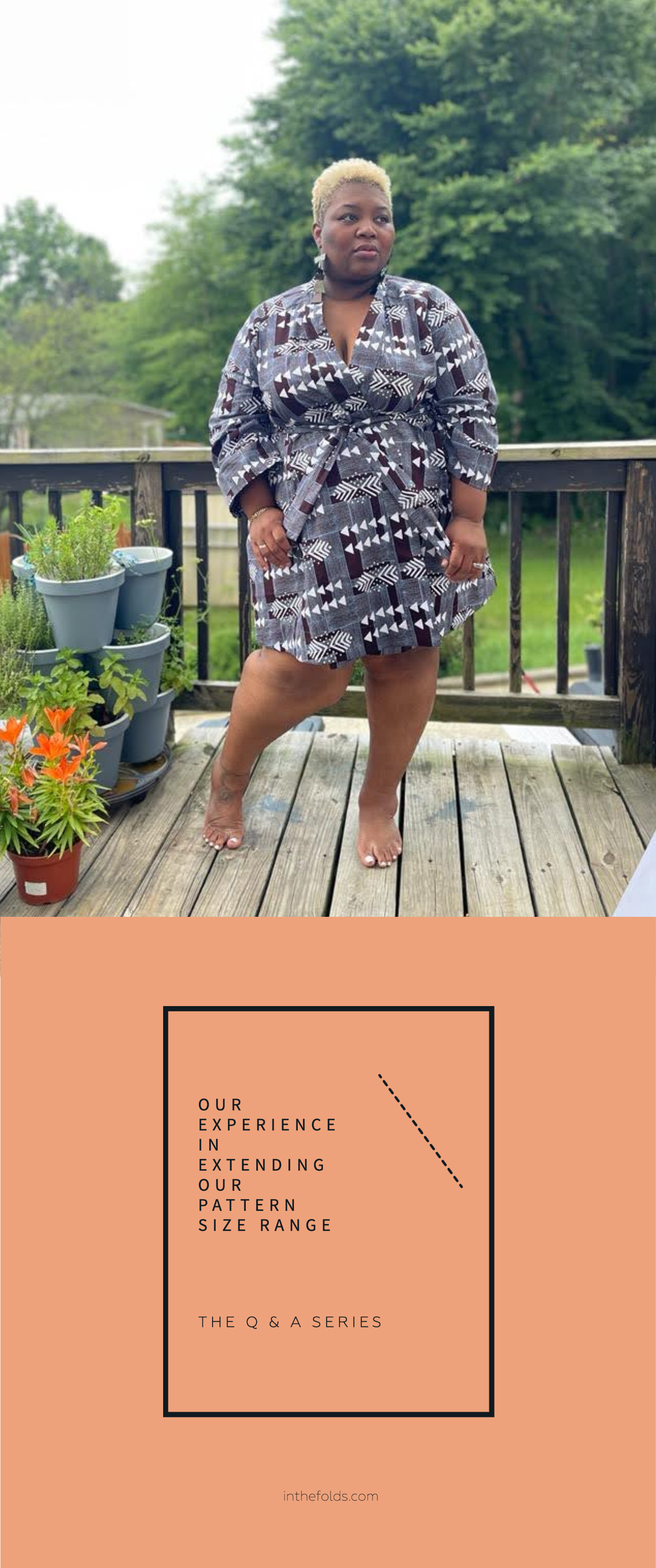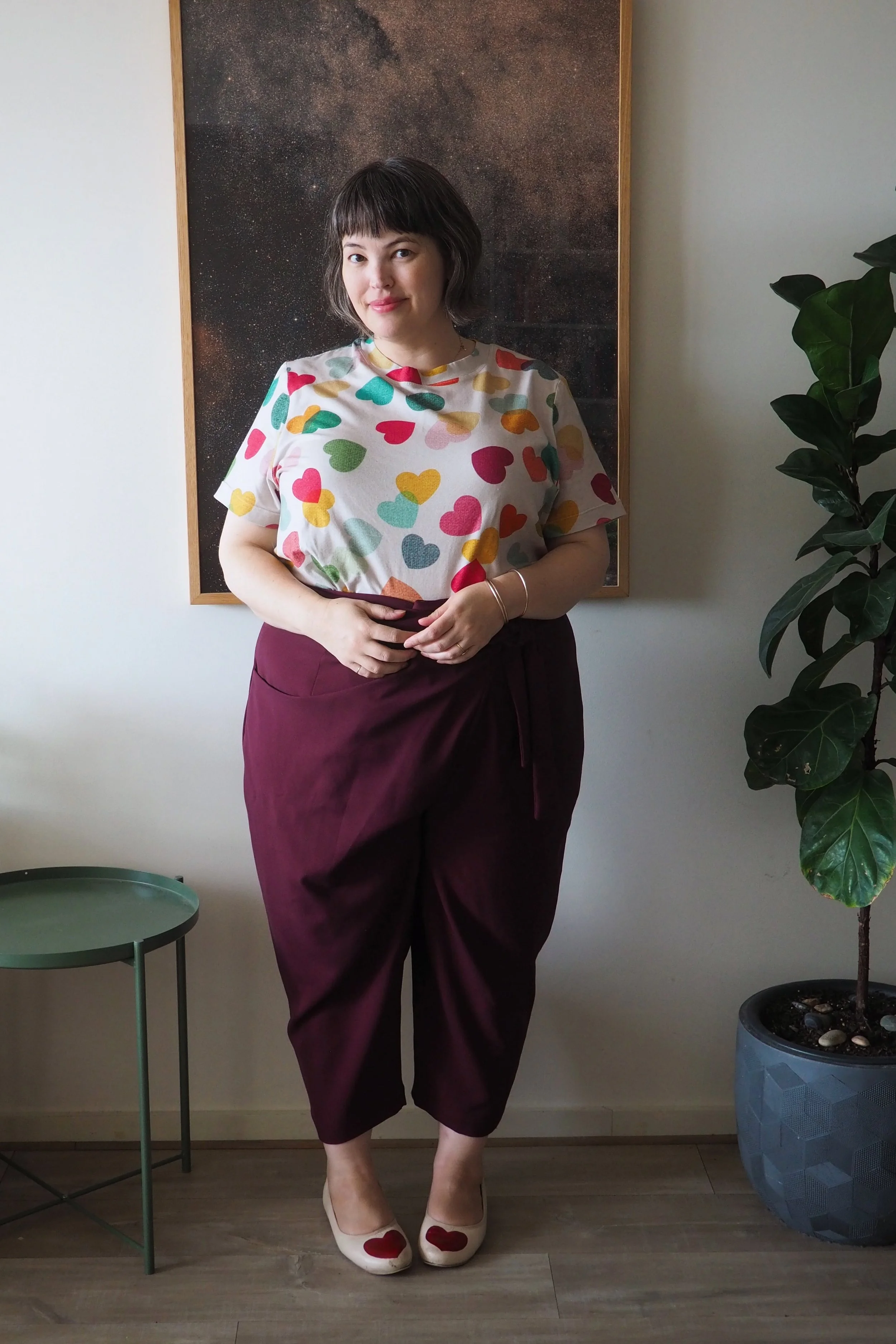THE Q & A SERIES
Our experience in extending our pattern size range
Hi again,
Could you talk more about your process of expanding your size range? It's really exciting to see your sizing expand!
A common challenge for plus size sewing is a huge lack of resources around how to draft patterns for larger sizes. It seems this is a problem on an industry level in fashion, schools, etc, as well as for home sewists and indie pattern companies.
Clearly knowledge exists, as clothing and patterns have been made in larger sizes. And more and more RTW and home sewing companies are putting out more sizes.
As far as I am aware, there is no book or central resource explaining how to draft larger sizes. As far as I can tell, it seems like indie sewing companies either have people who have figured out their own plus size block / drafting system and/or have access to industry biometric data. But this assumes they either have specialised knowledge already or access to professional resources that are not available to the average home sewist. Ie. it seems like there's a bit of an information desert.
Did you run into this challenge finding useful information in your size expansion process? Did you come across any useful resources? I am so curious about the process.
Thanks kindly,
Claire
Hi Claire,
This is a fantastic question. You’re right - there is definitely an information desert when it comes to resources about drafting patterns in larger sizes.
When we decided to extend the In the Folds size chart, this was by far the biggest hurdle.
I remember spending hours and hours googling everything I could think of to try and find the resources I needed to extend our size range. Or to find someone who could help us to do it.
the limitations of my fashion design degree with regards to grading for larger sizes
Although I have a Bachelor of Fashion Design and spent 4 years learning patternmaking, we unfortunately learned very little about extending the sizing of patterns. We learned to draft patterns using size 10 pattern blocks and size 10 mannequins.
We briefly learned to manually grade patterns, but never had to use the skill outside of that one lesson. The grading we were taught was an even grade - which means the pattern gets bigger or smaller by the same amount for each size. Although this works to an extent, there is a limit to how many sizes you can grade in this way. For example, if our base is a size 10, we can’t continue to grade the pattern with an even grade up to a size 36.
the hurdles of extending a size range
To extend our size chart, what we needed to do was create a new base pattern or block, in a larger size. Then the pattern would be graded from there - which would ensure accuracy because the pattern was actually designed for a larger body, rather than just a smaller size pattern getting larger.
After much googling, I found a company that could help me with extending our sizing. I had a few very interesting and inspiring conversations with the Director there and felt like her and her team really knew what they were doing.
Their team had a set of Alvanon mannequins and used professional 3D pattern drafting software to draft patterns and check them on 3D avatars. But they mainly worked with ready-to-wear brands, so their final products were patterns that would be sent off for commercial use, rather than home sewing.
Commercial patterns are very different to home sewing patterns
After some back and forth with the business we got our first pattern back, and at face value it looked pretty good. We conducted a fitting and there were a few minor issues that I wanted to discuss with the graders. When I started that conversation with the company, I realised that because they didn’t work within the home sewing space, it was difficult to communicate what I needed. For example, the term ‘Full Bust Adjustment’ is standard in the home sewing world, but this is not a commercial term. In industry, patterns are made in set sizes so there is no need for terms like this. Our plan was always to include a larger cup size in our extended range, so being able to articulate this in a way that would translate to our customers, was very important.
Following some discussion, I realised that we needed to go back to the drawing board and work with a patternmaker that had experience in the home sewing space. Of course, I was disappointed that the first attempt to extend our sizing had been unsuccessful and quite costly, but it gave us a chance to get clear about what we wanted to do and what was most important to us.
I am a perfectionist and do my best to create patterns that are as close to perfect as possible, so it was important that when we eventually did release patterns in our new size range, the quality and accuracy that our customers have come to expect ran through the extended size range too.
Plus size patternmaking is a specialist skill
My assistant, Alys, had previously worked with a patternmaker who specialised in plus size drafting and grading and I decided to try working with her. I sent off the same pattern as I had done with the other company and explained what we were trying to achieve. I could instantly tell that she understood our vision, but also had the background and technical skills to carry it out. She then sent back an altered pattern to fit our new size chart and it was time to do a fitting!
Our patternmaker has now become our most helpful resource when it comes to extending the size range of our patterns. The skills required for this particular part of patternmaking are very niche and it is hard to find a specialist in this area who also has an understanding of the home sewing industry. Her knowledge and experience of plus size patternmaking is what has allowed us to continue to extend the sizing of the patterns in the In the Folds catalogue.
Checking the fit: model or human?
The next step was to find a fit model to check the patterns on, which also proved difficult. I started researching whether we should be investing in an Alvanon mannequin, but at the end of the day knew this would never replace the need for a fit model.
We have a size 10 mannequin that we use for draping patterns and checking things as we go, but this never replaces the need for checking the fit of a pattern on an actual person. We tried to find a fit model with our size 24 measurements through modelling agencies in Sydney, but didn’t have any luck.
Then, we decided to look to our own network and advertised through our Instagram profile and mailing list, but of course received very few applications as most people who sit at the higher end or outside our current size range had no interest in hearing from us.
We had hoped to find someone we could work with in Sydney, but soon realised we were going to need to cast our net wider and put the call out internationally.
Thankfully, we found someone with our exact sample size measurements who was willing to try fit modelling remotely. We all knew it would be a work in progress and we would need to fine tune the process as we went. And I’m happy to say, this part of the process turned out to be a great success and we now have a fantastic relationship with our fit model. She sews the garment and photographs it on her body and answers questions about the fit. The main thing we have learned is that it’s important to communicate exactly what we are looking for and the questions we have about the fit of the pattern. Being able to work with the same person each time means things remain consistent and we can compare feedback between patterns.
the advantages of a plus size fit model
The main advantage of using a fit model, instead of just a mannequin, is that a fit model can provide context. They can tell you how a garment feels to wear, but can also compare it to other garments (both in ready-to-wear and garments they have made themselves). This was particularly important when extending our size range. For example, our fit model could say “I often find bicep width to be a problem in ready-to-wear, but I don’t have that problem in this sample.” This kind of feedback helps us know exactly what to look for and where plus size grading sometimes goes wrong, in both ready-to-wear and sewing patterns.
an overview of our plus size pattern grading process
The process of grading for our extended size range looks like this:
We send our largest size from our size A-J range (size 24) to our patternmaker. She alters the pattern to fit our size 24 block (with D cup bust).
We receive the altered pattern back and send it to our fit model to sew and fit. Sometimes we go back and forth a couple of times to make sure we’ve answered all our questions about how the garment fits.
We consolidate the feedback and either proceed of send feedback and alterations back to our patternmaker.
If required, our patternmaker alters the pattern. If the alterations are large scale, we send the updated version back to our fit model. If the changes are minor, the pattern is altered and then goes straight for grading into the full range.
HELPFUL RESOURCES
For designers looking to extend their size range, Alex from @adifferentstitch has a great resource which covers pretty much everything you need to consider.
You can also see all the patterns currently available in our extended size range here in our new Skills Library!
As I wrote this, I realised your question had two parts to it - what our process was for extending our size range, as well as where to find resources about drafting patterns for larger sizes. This week I’ve covered our process and in the next Q&A instalment I’ll give you some tips on drafting patterns for larger sizes.
Happy sewing,
Emily
RESOURCES MENTIONED IN THIS ISSUE
Opportunity Knocks: Tips for Inclusive Patterns by Alex of Fat Sewing Club - read the post here, and follow Alex on Instagram here.
View all In the Folds patterns currently in available in our extended size range in our new Skills Library here.
For more issues of the Q & A series, you can check out the archive here.
WHAT YOU’VE BEEN MAKING
Acton dress made by @jbaysews
Peppermint wrap top made by @sewizza









